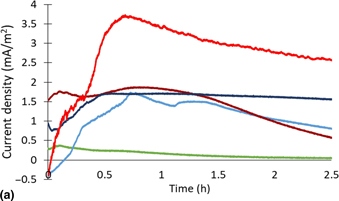Crossref Citations
This article has been cited by the following publications. This list is generated based on data provided by
Crossref.
Suo, Di
Fang, Zhen
Yu, Yang‐Yang
and
Yong, Yang‐Chun
2020.
Synthetic curli enables efficient microbial electrocatalysis with stainless‐steel electrode.
AIChE Journal,
Vol. 66,
Issue. 4,
Dong, Hong
Sarkes, Deborah A.
Stratis-Cullum, Dimitra N.
and
Hurley, Margaret M.
2021.
Direct conjugation of fluorescent quantum dots with E. coli via surface-displayed histidine-containing peptides.
Colloids and Surfaces B: Biointerfaces,
Vol. 203,
Issue. ,
p.
111730.
Nguyen, Van Thang
Tabish, Mohammad
Yasin, Ghulam
Bilal, Muhammad
Nguyen, The Huu
Van, Chung Pham
Nguyen-Tri, Phuong
Gupta, Ram K.
and
Nguyen, Tuan Anh
2021.
A facile strategy for the construction of TiO2/Ag nanohybrid-based polyethylene nanocomposite for antimicrobial applications.
Nano-Structures & Nano-Objects,
Vol. 25,
Issue. ,
p.
100671.
Jahnke, Justin P.
Sarkes, Deborah A.
Liba, Jessica L.
Sumner, James J.
and
Stratis-Cullum, Dimitra N.
2021.
Improved Microbial Fuel Cell Performance by Engineering E. coli for Enhanced Affinity to Gold.
Energies,
Vol. 14,
Issue. 17,
p.
5389.
Rezk, Hegazy
Olabi, Abdul Ghani
Abdelkareem, Mohammad Ali
and
Sayed, Enas Taha
2022.
Boosting the power density of two‐chamber microbial fuel cell: Modeling and optimization.
International Journal of Energy Research,
Vol. 46,
Issue. 15,
p.
20975.
Arif, Rezoana Bente
and
Mubarak, Nabisab Mujawar
2023.
Advanced Nanomaterials and Nanocomposites for Bioelectrochemical Systems.
p.
205.
Wang, Haowei
Zhu, Huawei
Zhang, Yanping
and
Li, Yin
2024.
Boosting electricity generation in biophotovoltaics through nanomaterials targeting specific cellular locations.
Renewable and Sustainable Energy Reviews,
Vol. 202,
Issue. ,
p.
114718.
Biradar, Madan R.
Mirgane, Harshad A.
Bhosale, Sidhanath V.
and
Bhosale, Sheshanath V.
2024.
Advancing energy storage with nitrogen containing biomaterials utilizing amino acid, peptide and protein: Current trends and future directions.
Journal of Energy Chemistry,
Vol. 99,
Issue. ,
p.
253.
Kaur, Pardeep
Saini, Preeti
Kaur, Sundeep
and
Shah, Maulin P.
2025.
Recent Trends in Electricity Generation from Lignocellulosic Biomass-Fueled Microbial Fuel Cells.
Indian Journal of Microbiology,
Vol. 65,
Issue. 2,
p.
555.


